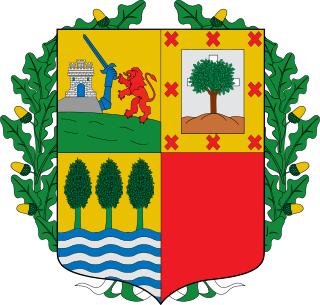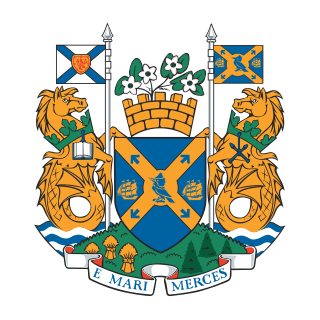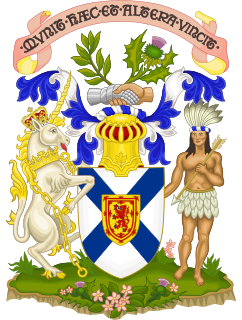 W
WThe coat of arms of Amsterdam is the official coat of arms symbol of the city of Amsterdam. It consists of a red shield and a black pale with three silver Saint Andrew's Crosses, the Imperial Crown of Austria, two golden lions, and the motto of Amsterdam. Several heraldic elements have their basis in the history of Amsterdam. The crosses and the crown can be found as decorations on different locations in the city.
 W
WThe current Basque coat of arms ) is the official coat of arms of the Basque Country, Autonomous community of Spain. It consists of a party per cross representing the three historical territories of Álava, Gipuzkoa and Biscay, as well as a fourth, void quarter. The arms are ringed by a regal wreath of oak leaves, symbolic of the Gernikako Arbola. The fourth quarter constituted since the late 19th century the linked chains of Navarre; however, following a legal suit by the Navarre Government claiming that the usage of the arms of a region on the flag of another was illegal, the Constitutional Court of Spain ordered the removal of the chains of Navarre in a judgement of 1986.
 W
WCoat of arms of the London Borough of Bexley is the official coat of arms of the London Borough of Bexley, granted on 20 May 1965.
 W
WThe coat of arms of Curaçao consists of a crown that expresses the link with the Dutch royal family. On the left side it shows a sailing boat that represents trade. In the middle the coat of arms of Amsterdam is shown, expressing the trading bond. On the right side stands a citrus tree.
 W
WThe coat of arms of Halifax, Nova Scotia is the full armorial achievement as used by the municipal government as an official symbol.
 W
WThe coat of arms of Nova Scotia is the heraldic symbol representing the Canadian province of Nova Scotia. It is the oldest provincial achievement of arms in Canada, and the oldest British coat of arms in use outside Great Britain. It is blazoned as follows: Argent, a saltire azure charged with an escutcheon of the Royal Arms of Scotland.
 W
WThe coat of arms of Solomon Islands shows a shield which is framed by a crocodile and a shark. The motto is displayed under it, which reads "To Lead Is to Serve". Over the shield there is a helmet with decorations, crowned by a stylised sun.
 W
WThe coat of arms of Wallis and Futuna consists of elements from the unofficial flag of Wallis and Futuna featuring a red saltire on a white square, which in turn is placed on a red field. The cross is placed on the lower right; the flag of France outlined in white on two sides is in the upper left quadrant.